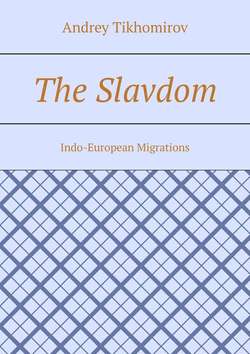The Slavdom. Indo-European Migrations

Реклама. ООО «ЛитРес», ИНН: 7719571260.
Оглавление
Andrey Tikhomirov. The Slavdom. Indo-European Migrations
The formation of the Slavic peoples
Slavic language development
Brief grammars of some Slavic languages
References
Отрывок из книги
Slavic peoples are based on Slavic languages that belong to the Indo-European language family. Modern Slavs are divided into 3 groups: eastern, southern and western. Belorussians, Russians and Ukrainians belong to the east, Bulgarians, Bosnians, Macedonians, Serbs, Slovenes, Croats and Montenegrins to the south, Kashubians (the ethnic group of Poles that inhabit part of Polish Pomerania – Kashubia), Luzhans, Poles, Slovaks and Czechs. Now these are states in which the majority of the above Slavic peoples are: Belarus, Russia, Ukraine, Bulgaria, Bosnia and Herzegovina, Northern Macedonia, Serbia, Slovenia, Croatia, Montenegro, Poland, Slovakia and the Czech Republic. Luzhichans (Lusatian Serbs, Sorbians, Vendians) live in eastern Germany.
Slavic peoples are currently distributed in large areas of Eastern and Central Europe, the Balkan Peninsula, Siberia and the Far East. The territory of their distribution throughout history has changed significantly. This is especially true for Russians. In some areas of Europe, Slavic peoples assimilated and disappeared. So it was, for example, on the territory of eastern Germany, the modern toponymy of which testifies to the ancient Slavic population of Brandenburg, Mecklenburg, Saxony and other neighboring regions. Back in the 18th century. Slavic speech was preserved on the Elbe (Slavic Laba) in the Lyukhov district on the River Yetz. The texts of the late 17th – early 18th centuries allow us to judge the Labab language.
.....
At the end of the first millennium BC. As a result of the advance to the south of Pomeranian tribes and ancient Germans from Jutland, a Przeworsk culture developed on the site of the Gluzhitsky culture, the territory of which was much wider. The reasons for this movement are unclear. The settlements of Przeworsk were located in elevated places. People lived in huts, were engaged in agriculture and cattle breeding. Iron sickles, axes, plowshares, and a large number of stucco ceramics are found in the cultural layers of Pshevor settlements. It is believed that it belonged equally to both the ancient Slavs and the ancient Germans. Moreover, it is impossible to territorially divide this culture into the Slavic and Germanic parts, into two regions, since at that time, at the turn of our era, both Germanic and Slavic tribes often changed their position, lived in strips, and the elements of their culture were mixed. The cultures described by us of the 1st millennium BC approximately give an idea of the territory of the formation of the ancient Slavs. However, it cannot be said which of these cultures was the oldest Slavic culture, although in the past there were quite determined attempts to connect one of them with the Slavs.
In the second century BC between the upper reaches of the Western Bug and the Middle Dnieper, that is, in the southern part of Belarus and in the forest-steppe Northern Ukraine, right up to Kiev in the south and Bryansk in the north, a Zarubin culture emerges. It is believed that the centers of the formation of this culture were in the western part of this territory. For four hundred years, the Zarubinets tribes were the only and numerous population of the forest-steppe Dnieper and Polesie, that is, those territories that are considered as ancient Slavic lands in eastern Europe. This culture has absorbed the traditions of a number of Proto-Slavic cultures, developed on their basis and on the territory that they occupied.
.....